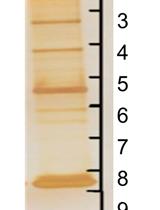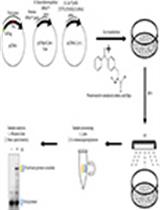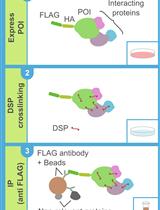- EN - English
- CN - 中文
Analysis of in vivo Interaction between RNA Binding Proteins and Their RNA Targets by UV Cross-linking and Immunoprecipitation (CLIP) Method
采用紫外线交联-免疫沉淀法(CLIP)分析RNA结合蛋白与其靶标RNA的体内互作
发布: 2017年05月20日第7卷第10期 DOI: 10.21769/BioProtoc.2274 浏览次数: 11462
评审: HongLok LungJingyu PengWeiyan Jia
Abstract
RNA metabolism is tightly controlled across different tissues and developmental stages, and its dysregulation is one of the molecular hallmarks of cancer. Through direct binding to specific sequence element(s), RNA binding proteins (RBPs) play a pivotal role in co- and post-transcriptional RNA regulatory events. We have recently demonstrated that, in pancreatic cancer cells, acquisition of a drug resistant (DR)-phenotype relied on upregulation of the polypyrimidine tract binding protein (PTBP1), which in turn is recruited to the pyruvate kinase pre-mRNA and favors splicing of the oncogenic PKM2 variant. Herein, we describe a step-by-step protocol of the ultraviolet (UV) light cross-linking and immunoprecipitation (CLIP) method to determine the direct binding of an RBP to specific regions of its target RNAs in adherent human cell lines.
Keywords: CLIP (CLIP)Background
While being transcribed in the nucleus, nascent RNAs are immediately assembled with trans-acting factors collectively named RNA binding proteins (RBPs). These factors interact directly with specific cis-acting regulatory sequences in RNA molecules, thus forming ribonucleoprotein (RNP) complexes (Dreyfuss et al., 2002; Singh et al., 2015). These complexes control co-transcriptional RNA processing events as well as post-transcriptional mechanisms involved in RNA metabolism, such as subcellular localization and translation. For instance, spliceosomal and cleavage/polyadenylation complex components recognize specific RNA elements in the pre-mRNA, permitting introns removal (Black, 2003) and coordination between 3’-end processing and transcription termination (Proudfoot, 2016). A large number of RBPs functions as splicing factors, by assisting recognition of constitutively and alternatively spliced exons by the spliceosome (Chen and Manley, 2009) or by improving usage of alternative polyadenylation signals (Tian and Manley, 2016). Likewise, RBP-mediated recognition of zip code localization elements allows transport and local translation of mRNA in the cytoplasm (Martin and Ephrussi, 2009).
Eukaryotic genomes encode a wide array of RBPs to fine-tune cell-specific gene expression programs in a time- and space-sensitive manner, thus contributing to tissue homeostasis. RNPs are highly dynamic structures, which remodel under the influence of specific cell signaling pathways that influence the fate of the RNA transcript (Naro and Sette, 2013; Fu and Ares, 2014). By precisely integrating co- and post-transcriptional RNA regulatory events, RBPs ensure the physiological adaptation in response to environmental constraints. It follows that the precise arrangement of RNP complexes must be highly coordinated and that deregulation of these complexes can be harmful for cells. Indeed, dysregulation of each aspect of RNA metabolism is involved in a large number of pathological conditions, such as neurodegenerative disease and cancer (Mayr and Bartel, 2009; Cooper et al., 2009; Silvera et al., 2010; Pagliarini et al., 2015). In cancer, aberrant alternative splicing regulation often yields splice variants that confer a selective advantage to the tumor, in terms of proliferation, metabolism, invasion, drug resistance and survival (David et al., 2010; Olshavsky et al., 2010; Paronetto et al., 2010; Valacca et al., 2010; Anczuków et al., 2012; Cappellari et al., 2014; Bielli et al., 2014; Calabretta et al., 2016). Moreover, specific splicing signatures correlate with cancer progression, and alteration of RBPs expression and/or of cis-regulatory elements can contribute to tumorigenesis (Cooper et al., 2009; Danan-Gotthold et al., 2015). High-throughput next-generation sequencing technologies now allow genome-wide identification of alternative splicing events associated with pathological processes (Chen and Weiss, 2015; Byron et al., 2016). Furthermore, they might help understanding the global complexity of RNA regulation and the correlation between binding sites for RBPs and the splicing outcome in health and disease (Wang and Burge, 2008). Thus, understanding alternative splicing changes in pathological conditions requires deciphering the regulatory network between RBPs and cis-regulatory elements and the identification of RBP binding sites is a key step in this direction.
In a recent study, we investigated the role of alternative splicing and RBPs in the acquisition of a drug-resistant (DR) phenotype in pancreatic ductal adenocarcinoma cells (PDAC) (Calabretta et al., 2016). We demonstrated that acquisition of the DR-phenotype relied on upregulation of the polypyrimidine tract binding protein (PTBP1), which is recruited to the PKM pre-mRNA and favors splicing of the oncogenic PKM2 variant. To investigate the recruitment of PTBP1 on PKM pre-mRNA in vivo, we used the UV cross-linking and immunoprecipitation (CLIP) experimental approach modified from Wang et al. (2009) protocol. Herein, we describe a step-by-step protocol to investigate the direct binding of a specific factor to its RNA target(s), which can be extended to most adherent human cell lines.
Materials and Reagents
- 100 mm dish
- PDAC cells or other adherent cells
- Cold PBS (Sigma-Aldrich, catalog number: D8537 )
- Liquid nitrogen
- Turbo DNAse (Thermo Fisher Scientific, AmbionTM, catalog number: AM2239 )
- Protein G Dynabeads (Thermo Fisher Scientific, NovexTM, catalog number: 10004D )
- RBP polyclonal hnRNP I antibody for immunoprecipitation (Santa Cruz Biotechnology, catalog number: sc-16547 )
- RNAse I (Thermo Fisher Scientific, InvitrogenTM, catalog number: AM2295 )
- Bradford solution (Bio-Rad Laboratories, catalog number: 500-0006 )
- Phenol:chloroform:isoamyl alcohol 25:24:1 (Sigma-Aldrich, catalog number: P3803 )
- Ethanol (VWR, catalog number: 20821.321 )
- Trizol (Thermo Fisher Scientific, AmbionTM, catalog number: 15596018 )
- Chloroform (Honeywell International, Riedel-de Haen, catalog number: 32211 )
- Isopropanol (CARLO ERBA Reagents, catalog number: 415156 )
- Agarose (Lonza, catalog number: 50004 )
- Water (Sigma-Aldrich, catalog number: W4502 )
- cDNA synthesis kit (Promega, catalog number: M1705 )
- Tris (VWR, catalog number: 0826 )
- Sodium chloride (NaCl) (VWR, catalog number: 27810.364 )
- Magnesium chloride (MgCl2) (Sigma-Aldrich, catalog number: M2670 )
- Calcium chloride (CaCl2) (Sigma-Aldrich, catalog number: C1016 )
- NP-40 (Alfa Aesar, Affymetrix/USB, catalog number: J19628 )
- Sodium deoxycholate (Sigma-Aldrich, catalog number: D6750 )
- Sodium dodecyl sulfate (SDS) (Sigma-Aldrich, catalog number: L3771 )
- DL-dithiothreitol (DTT) (Sigma-Aldrich, catalog number: D9779 )
- Protease inhibitor cocktail (Sigma-Aldrich, catalog number: P8340 )
- RNase inhibitor (Promega, catalog number: N2511 )
- EDTA (Sigma-Aldrich, catalog number: E5134 )
- Glycerol (Sigma-Aldrich, catalog number: G9012 )
- β-mercaptoethanol (Sigma-Aldrich, catalog number: M3148 )
- Bromphenol blue (Sigma-Aldrich, catalog number: 114391 )
- Proteinase K (Roche Molecular Systems, catalog number: 3115836001 )
- DEPC (Sigma-Aldrich, catalog number: D5758 )
- XQuantitative Real-Time PCR Kit (LightCycler®480 SYBR Green I Master) (Roche Molecular Systems, catalog number: 04887352001 )
- Sodium acetate (Sigma-Aldrich, catalog number: S2889 )
- Sodium metavanadate (Sigma-Aldrich, catalog number: 72060 )
- Lysis buffer (see Recipes)
- High-salt buffer (see Recipes)
- 3 M sodium acetate (pH 5.2) (see Recipes)
- Laemmli buffer (2x) (see Recipes)
- Proteinase K buffer (see Recipes)
Equipment
- Centrifuge
- UV crosslinker (Uvitec, model: CL 508 )
- SDS-PAGE and PVDF/nitrocellulose transfer apparatus (Bio-Rad Laboratories)
- Denaturating agarose gel apparatus (Bio-Rad Laboratories)
- Magnetic stand (Thermo Fisher Scientific, Invitrogen)
- Thermoblock
- Quantitative Real-Time PCR (Roche Molecular Systems, model: LightCycler® 480 )
- Sonicator (Hielscher ultrasonics, model: UP200S )
Procedure
文章信息
版权信息
© 2017 The Authors; exclusive licensee Bio-protocol LLC.
如何引用
Bielli, P. and Sette, C. (2017). Analysis of in vivo Interaction between RNA Binding Proteins and Their RNA Targets by UV Cross-linking and Immunoprecipitation (CLIP) Method. Bio-protocol 7(10): e2274. DOI: 10.21769/BioProtoc.2274.
分类
癌症生物学 > 癌症生物化学 > 蛋白质
生物化学 > 蛋白质 > 相互作用 > 交联
您对这篇实验方法有问题吗?
在此处发布您的问题,我们将邀请本文作者来回答。同时,我们会将您的问题发布到Bio-protocol Exchange,以便寻求社区成员的帮助。
Share
Bluesky
X
Copy link












